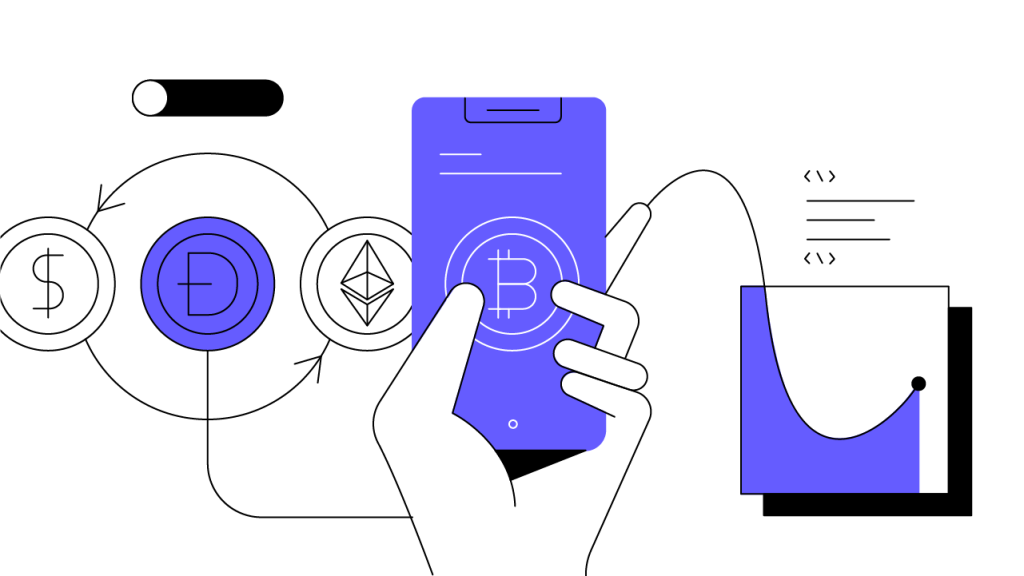How Do I Invest In and Trade Bitcoin?
Here’s how you can invest in bitcoin and other cryptocurrencies with just a few simple steps.
Updated February 26, 2025 • 3 min read

Summary
Over the past decade, bitcoin’s growth has attracted a new generation of investors*. But cryptocurrency is still a nascent asset class, and many interested investors may not know where to begin. With so many technologies, assets, exchanges, wallets, dashboards, and regulatory considerations to make, it’s imperative to educate yourself about the fundamentals and best practices of buying and selling bitcoin and other cryptocurrencies.
*Past performance is no guarantee of future returns
Buying Bitcoin Through a Cryptocurrency Exchange
If this is your first time buying cryptocurrency, you will need a way to exchange your fiat currency for crypto. For most investors, the easiest and safest way to do this is to create an account with a reputable cryptocurrency exchange. Crypto exchanges allow users to buy, sell, and hold cryptocurrencies. These organizations typically charge fees when you execute orders and withdraw funds. The process of funding your account and making a purchase on a cryptocurrency exchange is similar to what you would expect from most traditional online financial exchanges or brokerage accounts.
Unlock the future of money on Gemini
Start your crypto journey in minutes on the trusted crypto-native finance platform
Select an exchange: When deciding which exchange to use, it’s important to choose one that is licensed to operate within your local jurisdiction. You should also consider the exchange’s user features (such as minimum and maximum deposit and withdrawal limits, fee structure, and fund settlement times) and track record of security. Additionally, not every crypto exchange allows users to purchase cryptocurrencies using fiat currency (or vice versa), so if you are looking to buy bitcoin with fiat, be sure to select an exchange that provides this offering.
Connect your account to a payment option: After you’ve created an account on your crypto exchange of choice, the next step is to link your account to a payment source, such as a debit card or bank account. Each exchange has different fees and fund settlement times depending on how you choose to fund your account, so it’s important to choose the best payment option for your needs.
Buying Bitcoin for the First Time
Once you’ve transferred funds into your account, you’re ready to make your first cryptocurrency purchase.
Select a trading pair: When placing an order on a cryptocurrency exchange, you need to select a “trading pair,” which refers to the pair of assets traded in an order. If you are exchanging U.S. dollars for bitcoin (BTC), the relevant trading pair would be USD/BTC. Each exchange offers its own set of trading pairs. Due to regulatory constraints, most exchanges only allow you to exchange fiat currency for either bitcoin (BTC) or ether (ETH). This means if you want to purchase a smaller-cap altcoin using fiat, you will most likely need to first convert your fiat to either BTC or ETH before exchanging it for your cryptocurrency of choice.
Place your order: After you’ve selected your trading pair, the next step is to place an order. Let’s focus on the two most common order types: market and limit orders. If they sound familiar, that’s because the order types you see on a crypto exchange operate the same way as they do on a traditional brokerage account.
Market orders: A market order is a request to buy or sell a cryptocurrency at the best available price in the current market. Since market orders are filled nearly instantaneously for cryptocurrencies with a high level of liquidity, this type of order is generally considered the fastest and most reliable way to enter or exit a trade. However, since market orders are executed regardless of price at the time the order is placed, investors are at risk of experiencing slippage – the difference between the anticipated price of a trade and the price at which the trade is executed – particularly during periods of high volatility.
Limit orders: A limit order is a request to buy or sell a cryptocurrency at a specified price or better, which gives you better control of the trading price than you get with a market order. Buy limit orders are only executed at or below the price you stipulate, and sell limit orders are only executed at or above your stipulated limit price. While limit orders eliminate slippage risk, there is a chance your order may not be filled, since trade execution is dependent on the prices you’ve set, not just what’s available on the market.
Some crypto exchanges also offer advanced trading options such as margin trading and perpetual swaps.
I Bought Bitcoin. Now What?
Once you’ve bought bitcoin, what you do with it is entirely up to you. Some investors choose to trade it for other cryptocurrencies and tokens that can be used on the many platforms and networks that make up the blockchain ecosystem. Other cryptocurrency owners prefer to hold onto their bitcoin (“HODL,” as they say) over the long run as a store of value.
When deciding what to do with your crypto, here are a few things to consider:
Be mindful of taxes: Given the significant differences in crypto policies across different parts of the world, it’s important to be mindful of the tax implications of your crypto trades. For instance, in the U.S., cryptocurrencies are treated as capital assets (i.e. property), meaning that any trade or sale of crypto is subject to capital gains taxes.
Don’t rely on hype: Now that you have invested in bitcoin, you may want to invest in other cryptocurrency projects. However, it’s important to realize that not every cryptocurrency is designed to be a form of online money, and that the likelihood of a cryptocurrency appreciating in value is highly dependent on its tokenomics and user adoption. Before buying any cryptocurrency, research the project’s intended use case, token economy, and track record instead of relying on marketing gimmicks and hype.
Set up price alerts: Instead of watching crypto price charts 24/7, you may be better off setting specific price alerts for the cryptocurrencies that you’re interested in. While limit orders can be used to automatically execute trades based on pre-set price parameters, price alerts allow you to passively stay informed on significant market shifts and give you time to capitalize on unexpected price fluctuations if you wish.
Protect your crypto: When investing in and trading cryptocurrencies, it’s important to enact safe internet practices such as Two-Factor Authentication (2FA) in order to protect your crypto exchange account and its funds. Since most on-chain transactions cannot be reversed, there is little recourse for recovering lost funds if you are hacked or accidentally transfer your funds to an unknown wallet.
Cryptopedia does not guarantee the reliability of the Site content and shall not be held liable for any errors, omissions, or inaccuracies. The opinions and views expressed in any Cryptopedia article are solely those of the author(s) and do not reflect the opinions of Gemini or its management. The information provided on the Site is for informational purposes only, and it does not constitute an endorsement of any of the products and services discussed or investment, financial, or trading advice. A qualified professional should be consulted prior to making financial decisions. Please visit our Cryptopedia Site Policy to learn more.

Is this article helpful?


